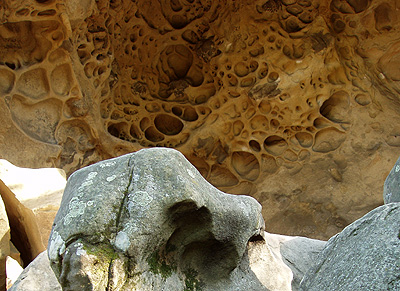
The museum has recently mounted expeditions to find and document a rare natural art form known as "tafoni". Tafoni is a type of rock on which weathering has produced a zymoglyphic result. The rock results from a combination of tectonic activity and our Mediterranean climate. San Mateo is very close to the San Andreas Fault, where two of the earth's major tectonic plates grind together. Crossing the Crystal Springs Reservoir into the hills to the west takes you across the fault, from the North American Plate to the Pacific Plate. Over the millenia, the seismic ferment has caused ancient sea beds to be pushed upwards and become land. In some places, fossilized remnants of these sea beds are exposed as isolated knobs of sandstone.
Once exposed, the weathering begins. The rock absorbs water during our wet season, dissolving calcium from ancient bits of sea shells. During the dry season, the evaporation of the water draws the calcium to the surface, resulting in an uneven erosion of the remaining rock. The result is an evocative combination of sinewy fretwork and miniature troglodyte landscapes.
These rocks can be seen at the "Sandstone Formation" on the Tafoni Trail in El Corte de Madera Creek Open Space Preserve and a number of locations in Castle Rock State Park. More expedition photos, and a graphic showing how tafoni forms, can be seen here. Tafoni also forms in rocks along the local beaches and some excellent photos of it by tafoni aficionado Dawn Endico can be seen here.
Further details on rock formations in the Bay Area
1 comment:
Very beautiful, and unusual! I've never seen those formations before.
Post a Comment